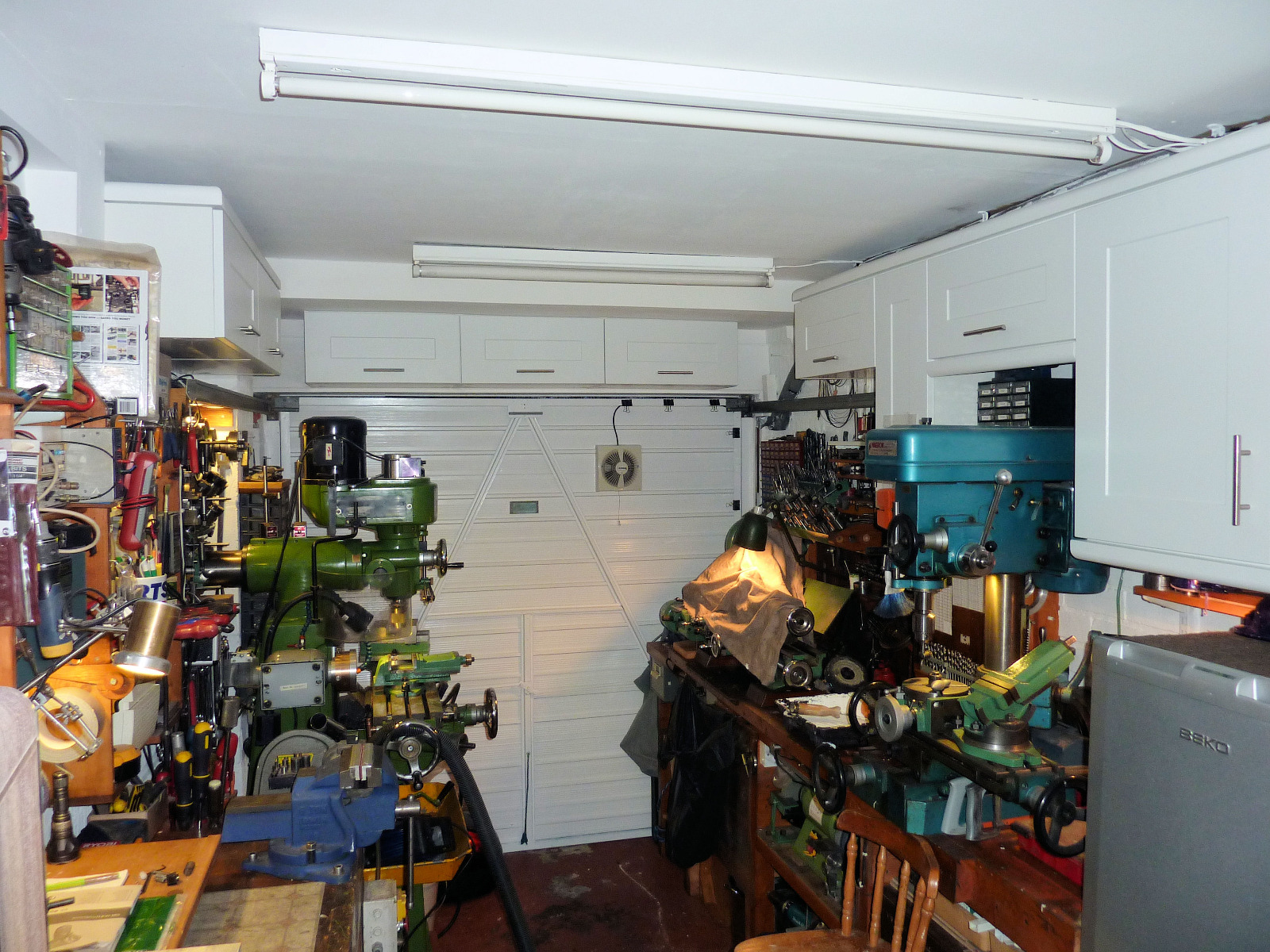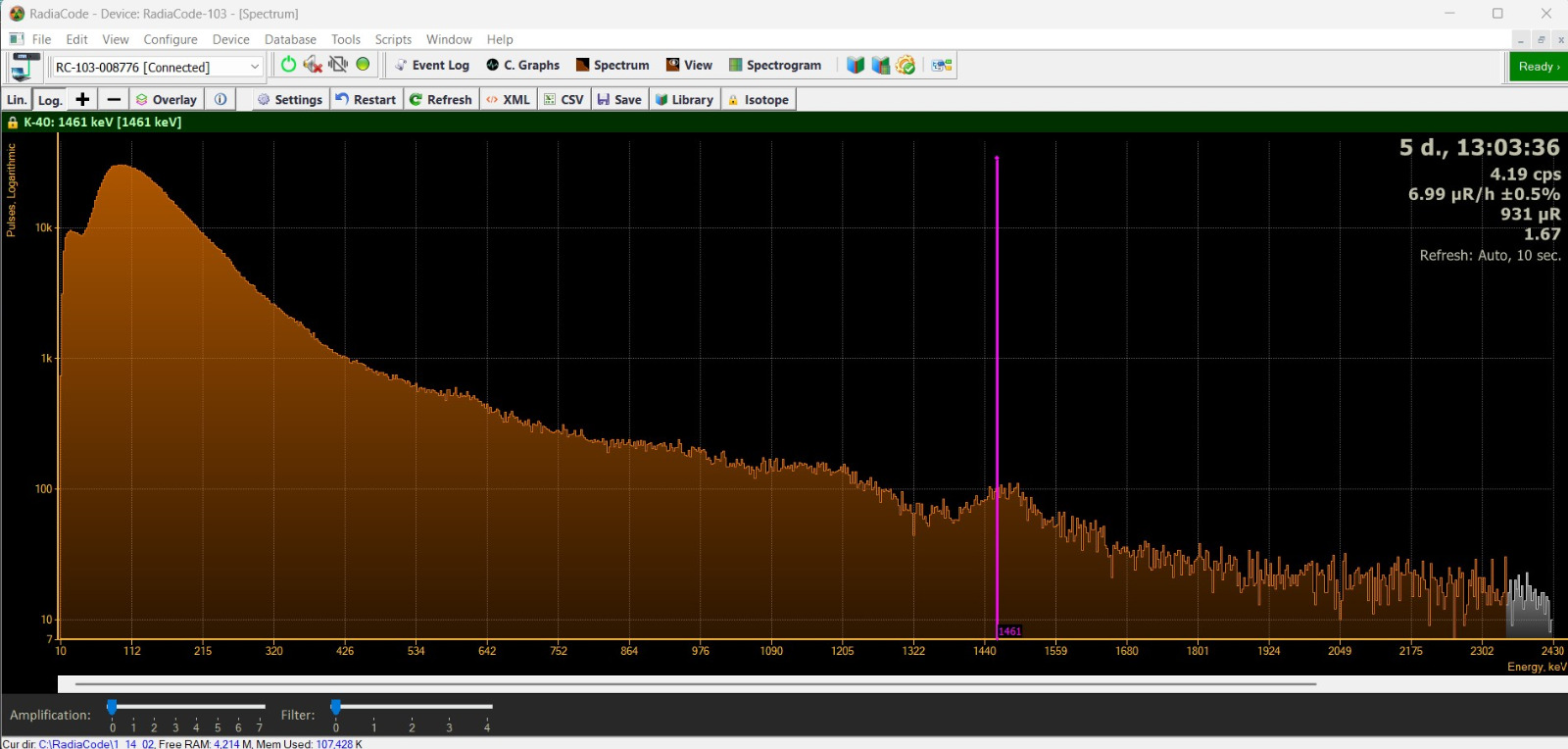×
Gamma Spectroscopy
Detecting K-40 in bananas with Radiocode RC103
- ChrisLX200
-
 Topic Author
Topic Author
- Offline
- Elite Member
-

Less
More
- Posts: 161
- Thank you received: 8
7 months 2 weeks ago #7237
by ChrisLX200
Replied by ChrisLX200 on topic Detecting K-40 in bananas with Radiocode RC103
It's one of those Russian compasses, spicy enough for me and it should provide a good spectrogram in a short time.
Please Log in or Create an account to join the conversation.
7 months 2 weeks ago - 7 months 2 weeks ago #7238
by Simomax
Replied by Simomax on topic Detecting K-40 in bananas with Radiocode RC103
An Adrianov compass? Such as this:
https://www.ebay.co.uk/itm/284975067457?_skw=Adrianov+compass
I have never seen nor heard of these, if it is in fact that.
I thought of an idea for a reasonable shielded chamber using two steel tubes/pipes, some other bits of steel and lead to make a small, but effective chamber for sampling. Effectively a 2" tube inside a 4" tube, filled with molten lead and a couple of end caps to seal it up. ChatGPT thinks it would work well. I've attached the relevant parts of the conversation, which describes the construction. It should allow for a decent chamber with the minimum of lead. It's still gonna take a load, but looks like a good shout if you have access to the materials, and can cut a bit of steel. It could be made maybe 200-250mm long. it should be large enough for the Radiacode and most sources.
I thought of an idea for a reasonable shielded chamber using two steel tubes/pipes, some other bits of steel and lead to make a small, but effective chamber for sampling. Effectively a 2" tube inside a 4" tube, filled with molten lead and a couple of end caps to seal it up. ChatGPT thinks it would work well. I've attached the relevant parts of the conversation, which describes the construction. It should allow for a decent chamber with the minimum of lead. It's still gonna take a load, but looks like a good shout if you have access to the materials, and can cut a bit of steel. It could be made maybe 200-250mm long. it should be large enough for the Radiacode and most sources.
Last edit: 7 months 2 weeks ago by Simomax.
Please Log in or Create an account to join the conversation.
- ChrisLX200
-
 Topic Author
Topic Author
- Offline
- Elite Member
-

Less
More
- Posts: 161
- Thank you received: 8
7 months 2 weeks ago #7239
by ChrisLX200
Replied by ChrisLX200 on topic Detecting K-40 in bananas with Radiocode RC103
Yes it's exactly that, though from a different seller (who I cannot recommend to be honest). Ordered on the 17th of last month and posted to me just today, it doesn't actually take long to get here from Ukraine, maybe a week.
The tube idea sounds promising and I actually thought of something similar to make a lead pig. I have everything needed to make such a chamber in the other part of my garage! I have both 6" tube and could perhaps use 2-1/2" or 3" tube to make a cavity (thinking ahead in case I ever buy a 2" detector).
The tube idea sounds promising and I actually thought of something similar to make a lead pig. I have everything needed to make such a chamber in the other part of my garage! I have both 6" tube and could perhaps use 2-1/2" or 3" tube to make a cavity (thinking ahead in case I ever buy a 2" detector).
Attachments:
Please Log in or Create an account to join the conversation.
7 months 2 weeks ago #7240
by Simomax
Replied by Simomax on topic Detecting K-40 in bananas with Radiocode RC103
I have been thinking about the 'tube chamber' and I don't see any reason why it couldn't also be done with square section steel tube, or even just sheet welded together to form a tube. It makes it a little harder for the threaded rods as the the end caps would have to be a bit larger than the outer tube, but then if wrangling steel with a welder, there's no reason tabs couldn't be welded on and captive nuts or similar used. that would make it a little tidier. Working with a square would also make fabricating the end caps easier, though would also use up a little more lead, but not too much though. I have a friend that has a metal working shop/business. I'll go and see him and see what scrap he has laying about.
Please Log in or Create an account to join the conversation.
- ChrisLX200
-
 Topic Author
Topic Author
- Offline
- Elite Member
-

Less
More
- Posts: 161
- Thank you received: 8
7 months 2 weeks ago #7241
by ChrisLX200
Replied by ChrisLX200 on topic Detecting K-40 in bananas with Radiocode RC103
Round tube is easier for me because I can make the end caps and separator (between inner and outer tube) on the lathe. There needs to be a really good seal on the bottom end when pouring lead into it or it will leak. Using copper tube as the inner tube would also solve the problem of having liner, I think I had something suitable but not sure. I certainly have some 3" brass tube lying around somewhere, not sure if that would substitute for copper. I found something suitable to melt the required amount of lead in - an old stainless steel stock pot. Getting enough heat into it is another story!
Up to 133 hours no the background capture now:
Up to 133 hours no the background capture now:
Attachments:
Please Log in or Create an account to join the conversation.
7 months 2 weeks ago #7242
by Simomax
Replied by Simomax on topic Detecting K-40 in bananas with Radiocode RC103
Just a quick reply whilst I eat my lunch.
The seal at the bottom doesn't matter too much as long as it is flat onto a heat resistant material. Without any seal a little lead may slip through, but as soon as it cools it will fill the gaps and no more should come out. Simply trim any surplus off. Or use something like silicone sealer to create a bead seal around the inside or the inner tube and the outside of the outer, pour and remove silicone when done.
Brass will sorta work, but not as well as copper or aluminium. Copper and aluminium are low-Z (low atomic number) materials. They are poor bremsstrahlung producers, but good X-ray absorbers at lower energies. Brass is an alloy (mostly copper and zinc), with a higher average atomic number than pure aluminium and slightly higher than pure copper, especially with certain compositions. Brass is worse than aluminium, and slightly worse or comparable to copper (depending on zinc content), for bremsstrahlung suppression. If you have aluminium, use that, if not then use copper. It only has to be thin, ~0.5mm. Aluminium foil will also work, but unsure about the thickness of a single sheet.
I use an old cast iron milk pan for melting lead. It has a large thermal mass, solid as, doesn't deform and lead just will not stick to it. Your SS pan may work if it has a thick bottom, if not you may struggle getting enough heat into it. I have always used a gas stove (when the wife is out of the house ) or a camping stove. I have always heated the cast iron pan up a lot before adding lead, this seems to help speed things up, and the lead can then be melted in small parts, if possible. Also with a flame under the pan, a blowtorch really helps to heat the top, until it is all molten.
I think I'm going to go for a square chamber. Not sure exactly what size. That depends on what scrap my friend has laying about. I am going for 1" / ~25mm lead filling and 1/4" / ~6mm steel wall, so a total of 12mm steel, 25mm lead and 0.5mm aluminium. I may even place some nice vinyl on the inside and outside to make it look pretty! I'll knock up a 3d design later. If you have a hydraulic press you could assemble it all, place the end caps on (filled with 25mm lead (or whatever you are doing) and then press it a little. This should give a nice slight indent into the lead for when the caps are placed onto the tube/chamber.
The seal at the bottom doesn't matter too much as long as it is flat onto a heat resistant material. Without any seal a little lead may slip through, but as soon as it cools it will fill the gaps and no more should come out. Simply trim any surplus off. Or use something like silicone sealer to create a bead seal around the inside or the inner tube and the outside of the outer, pour and remove silicone when done.
Brass will sorta work, but not as well as copper or aluminium. Copper and aluminium are low-Z (low atomic number) materials. They are poor bremsstrahlung producers, but good X-ray absorbers at lower energies. Brass is an alloy (mostly copper and zinc), with a higher average atomic number than pure aluminium and slightly higher than pure copper, especially with certain compositions. Brass is worse than aluminium, and slightly worse or comparable to copper (depending on zinc content), for bremsstrahlung suppression. If you have aluminium, use that, if not then use copper. It only has to be thin, ~0.5mm. Aluminium foil will also work, but unsure about the thickness of a single sheet.
I use an old cast iron milk pan for melting lead. It has a large thermal mass, solid as, doesn't deform and lead just will not stick to it. Your SS pan may work if it has a thick bottom, if not you may struggle getting enough heat into it. I have always used a gas stove (when the wife is out of the house ) or a camping stove. I have always heated the cast iron pan up a lot before adding lead, this seems to help speed things up, and the lead can then be melted in small parts, if possible. Also with a flame under the pan, a blowtorch really helps to heat the top, until it is all molten.
I think I'm going to go for a square chamber. Not sure exactly what size. That depends on what scrap my friend has laying about. I am going for 1" / ~25mm lead filling and 1/4" / ~6mm steel wall, so a total of 12mm steel, 25mm lead and 0.5mm aluminium. I may even place some nice vinyl on the inside and outside to make it look pretty! I'll knock up a 3d design later. If you have a hydraulic press you could assemble it all, place the end caps on (filled with 25mm lead (or whatever you are doing) and then press it a little. This should give a nice slight indent into the lead for when the caps are placed onto the tube/chamber.
Please Log in or Create an account to join the conversation.
Time to create page: 0.218 seconds


